Welcome to Sumkoka
English
- All
- Product Name
- Product Keyword
- Product Model
- Product Summary
- Product Description
- Multi Field Search
Views: 0 Author: Site Editor Publish Time: 2025-11-17 Origin: Site








As the global food delivery and takeaway market continues to expand, the demand for reliable, safe, and sustainable food packaging has increased dramatically. Restaurants, bakeries, cloud kitchens, and catering businesses all rely on disposable to-go containers to transport meals efficiently. Among the many types of food service containers, bagasse containers and aluminum foil containers are two of the most widely used. Each has its own characteristics, advantages, and ideal use cases.
This article provides a detailed comparison of bagasse and aluminum foil containers—from environmental impact to performance, cost, food safety, and business suitability—to help you choose the best packaging for your needs.
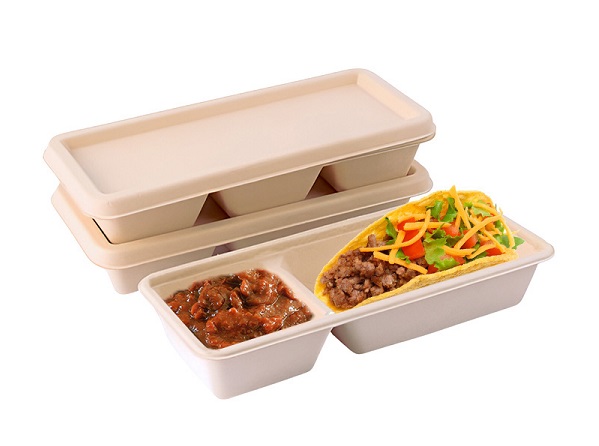
Bagasse is the dry, fibrous residue that remains after sugarcane stalks are crushed to extract their juice. Historically, this fibrous material was treated as waste or burned as fuel in sugar mills. However, modern innovation has repurposed this agricultural byproduct into a high-value material for environmentally friendly food packaging.
The transformation from waste to bagasse food container is a fascinating example of the circular economy:
Extraction: Sugarcane is harvested and crushed for juice. The remaining fiber is collected.
Cleaning and Pulping: The fibers are cooked, cleaned, and turned into a pulp, similar to the process of making paper but using less energy and fewer chemicals.
Molding: This wet pulp is pressed into high-heat molds. This is where the shape is defined, creating everything from a bagasse bowl to clamshell containers and to go plates.
Optional coating: Some bagasse food containers receive a thin PLA or PE lining to improve oil and water resistance.
Finishing: The containers are sterilized and trimmed. The result is a sturdy, matte-finished container that feels somewhat like thick, textured paper but is significantly stronger.
Plant-based and biodegradable
Compostable in industrial or natural environments
Sturdy, thick texture similar to paper-pulp molded products
Comes in various takeout container sizes and styles, such as bagasse clamshells, bowls, sandwich containers, lunchable containers, and more
Because they are made from a rapidly renewable plant resource (sugarcane grows back in less than a year), bagasse products are fully compostable and biodegradable.
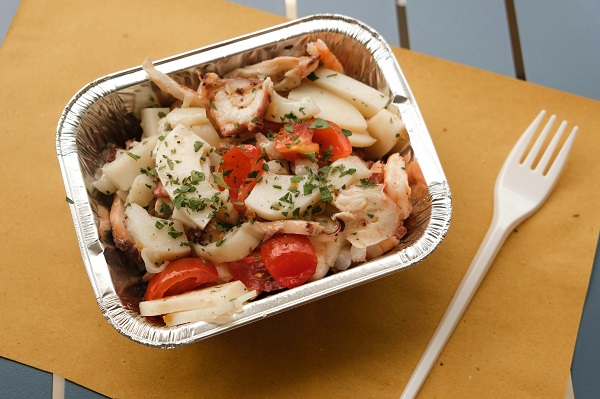
Aluminum foil containers—often referred to as aluminum pans, foil trays, or disposable baking pans—are the heavyweights of the food service industry. They have been the standard for decades, particularly for foods that require heat retention or oven finishing.
These containers are made from aluminum alloy sheets. Aluminum is a metal element that is abundant in the earth's crust (in the form of Bauxite ore). The foil used for containers is rolled to a specific thickness to ensure rigidity while remaining lightweight.
Rolling: Large ingots of aluminum are rolled through heavy mills until they reach the desired gauge (thickness).
Lubrication: A food-safe lubricant is applied to the sheet to assist in the molding process.
Stamping: The foil sheet is fed into a press where a die stamps it into the specific shape of a foil pan or aluminum tray.
Rim Formation: The edges are curled or hemmed to create a safe rim that provides structural integrity and allows for food containers with lids to be sealed (often with board or plastic lids).
Excellent heat resistance and thermal conductivity
Safe for ovens, freezers, and sometimes microwaves
Naturally oil-proof and water-proof
Lightweight yet strong enough for hot or greasy foods
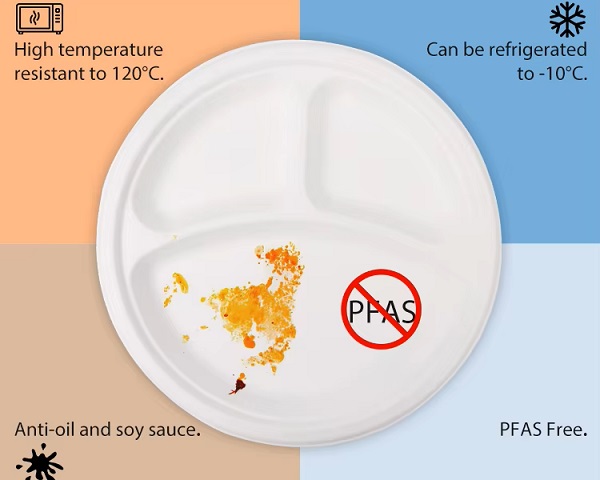
1. Eco-Friendly and Sustainable
Bagasse is renewable and biodegradable, making it one of the best options for sustainable food packaging. It composts naturally within 60–120 days.
2. Safe for Food Contact
Because they are plant-based, bagasse containers typically contain no harmful chemicals like heavy metals or petroleum byproducts.
3. Strong, Thick, and Durable
Bagasse containers hold both dry and moist foods well. A bagasse food container maintains shape under normal use and is popular for salads, rice dishes, sandwiches, and more.
4. Microwave-Safe
Bagasse products can be microwaved safely for short reheating periods (up to ~120 °C or ~248 °F).
5. Good for Branding
Businesses focused on green initiatives often choose bagasse to demonstrate environmental commitment.
6. Breathability
Bagasse prevents condensation buildup better than plastic, keeping fried foods from getting soggy too quickly.
1. Limited Oven Resistance
Bagasse cannot withstand the high temperatures of baking or long reheating in an oven.
2. Moisture Sensitivity
While grease-resistant, prolonged exposure to very hot liquids can sometimes soften the container over long periods.
3. Lids
While many have locking tabs, getting a purely leak-proof seal can be harder compared to plastic snap-ons, though technology is improving.
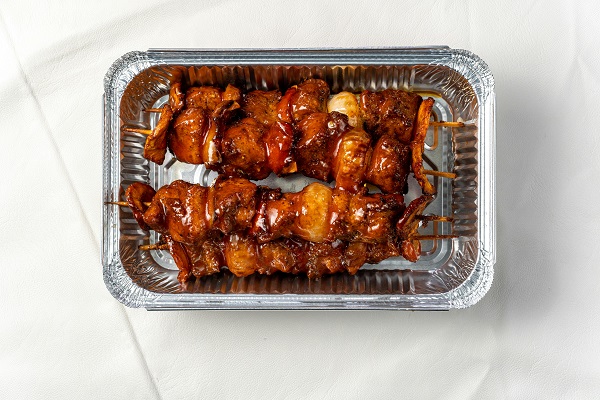
1. Extreme Heat Resistance
Aluminum foil containers can withstand temperatures up to 400–600 °C (752–1112 °F), making them ideal for baking, grilling, and oven-to-table food service. It is the only disposable container that can handle direct fire or broiler heat.
2. Excellent Thermal Conductivity
Keeps food warm longer and ensures even heating—important for roasted meats, baked pasta, lasagna, and similar dishes.
3. Grease and Moisture Barrier
Aluminum is completely impermeable to grease and moisture. It will never get soggy, no matter how much gravy or sauce is in the quart takeout container.
4. Freezer-to-Oven Convenience
Great for meal prep businesses, frozen food companies, and restaurants offering bake-at-home dishes.
5. Recyclable
Clean aluminum foil containers are 100% recyclable and infinitely reusable in the materials cycle.
1. Recycling Is Waste-Sensitive
If contaminated with grease or food residue, many recycling facilities reject them.
2. Not All Types Are Microwave-Safe
Some microwaves may react poorly to foil; while many modern microwaves allow thin foil, it must be used carefully.
3. Easily Deformed
Aluminum trays can bend under pressure if too thin.
4. Not Compostable
While recyclable, aluminum foil containers are not biodegradable like bagasse.
Feature | Bagasse Containers | Aluminum Foil Containers |
Raw Material | Sugarcane Pulp (Renewable) | Aluminum Alloy (Mineral) |
Disposal | Compostable / Biodegradable | Recyclable |
Microwave Safe? | Yes | No (Fire Hazard) |
Oven Safe? | Yes (up to ~200°C, limited time) | Yes (High heat, direct flame) |
Insulation | Good, stays cool to touch | Poor, gets very hot |
Leak Resistance | Good (but can soften over time) | Excellent (Impermeable) |
Best Use | Burgers, Salads, Rice, Microwavable meals | Baking, Heavy Pastas, Roasts, BBQ |
Common Products | Clamshells, Bowls, Plates | Pans, Trays, Rounds |
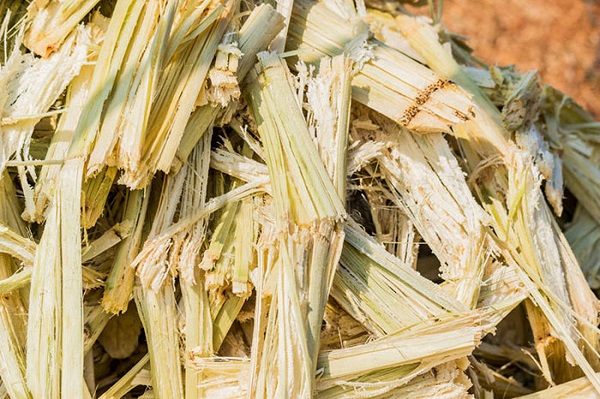
When choosing between bagasse containers and aluminum foil containers, understanding the environmental cost goes beyond just how the product looks. We must consider the entire lifecycle, from the extraction of raw materials to how the food service containers are disposed of after the meal.
Bagasse: Bagasse represents the ultimate upcycling story in sustainable food packaging. It is a fibrous by-product of sugarcane processing. Because it utilizes agricultural waste that would otherwise be burned or discarded, it does not require dedicated land to be cleared for production. It is a rapidly renewable resource, as sugarcane can be harvested annually.
Aluminum: In contrast, aluminum is a mineral-based material extracted from Bauxite ore. The process involves open-pit mining, which can lead to soil erosion and habitat disruption. Transforming Bauxite into aluminum is an energy-intensive electrolytic process, making the initial sourcing of an aluminum container significantly more taxing on the environment than plant-based alternatives.
Bagasse Containers: These are designed for the circular economy. As environmentally friendly food packaging, bagasse is fully compostable. Under commercial composting conditions, it decomposes into natural biomass and nutrient-rich soil within 60 to 90 days. Even in a home compost setting, it breaks down safely, leaving no toxic residue.
Aluminum Trays: Aluminum is theoretically "infinitely recyclable," meaning it can be melted down and reused forever without losing quality. However, there is a major caveat in the food industry: contamination. An aluminum tray covered in cheese, grease, or sauce is often rejected by recycling facilities. If consumers do not thoroughly clean the container before binning it, it ends up in a landfill, where it will sit for centuries.
Production Emissions: The manufacturing of bagasse food containers generally has a lower carbon footprint. The production process is mechanical and thermal (pulping and molding) rather than chemical and electrolytic, consuming less overall energy.
The Recycling Offset: While the initial production of aluminum emits high levels of greenhouse gases, recycling aluminum uses only 5% of the energy required to produce new aluminum. Therefore, if an aluminum foil container is successfully recycled, its carbon impact drops tightly. However, because many takeout containers are discarded rather than recycled due to food residue, the real-world carbon footprint of single-use foil often remains higher than that of bagasse.

Aluminum: You can bake lasagnas, casseroles, or brownies directly in disposable baking pans and sell them. It can withstand temperatures exceeding 400 ℉ (200℃). However, it cannot be microwaved.
Bagasse: Bagasse is microwave-safe, which is a massive convenience for customers reheating take out boxes at home. It is also oven safe up to roughly 200℃ for short durations, but it is not designed for baking heavy dishes from raw states like aluminum is.
Bagasse: Being a fibrous material, it holds heat reasonably well and doesn't conduct heat to the hands as fast as metal. A bagasse bowl holding hot soup is easier to hold than a metal one.
Aluminum: Aluminum is a conductor. It transfers heat rapidly. Without a cardboard sleeve or a protective box, a hot aluminum foil container can burn fingers. However, with a lid, it traps steam very effectively.
Aluminum: It is malleable. If you squeeze a takeout container made of foil, it bends. Heavy items require a thicker gauge or support underneath.
Bagasse: It is rigid and sturdy. It stacks well. However, once it becomes saturated (after hours of holding liquid), that rigidity drops.
Choosing the right packaging is not just about holding food; it is about preserving its quality during transport. The distinct physical properties of bagasse and aluminum make them suitable for vastly different culinary environments.
Bagasse containers are the preferred choice for businesses that prioritize texture, presentation, and immediate convenience. Because the material is breathable, it prevents the "steaming effect" that often happens with plastic, making it excellent for foods that need to stay crisp or fresh.
Best Used For:
Light and Fresh Fare: They are perfect for salads and healthy meals where presentation is key. The natural matte finish provides a rustic backdrop for vibrant ingredients.
Daily Staples: Whether it is rice bowls, sandwiches, or deli foods, bagasse manages moisture well, preventing bread and grains from becoming soggy during a lunch commute.
The "Eco-Conscious" Brand: For eco-friendly restaurants and cafes, using bagasse is a visible commitment to sustainability. It tells customers that the packaging is as healthy as the food.
Microwave Convenience: These are the ultimate solution for businesses needing clamshell containers or lunch containers for daily meals that might require short reheating in microwaves. Customers appreciate the ability to warm up leftovers without transferring them to a ceramic plate.
Common Products in This Category:
Bagasse bowls: Perfect for poke, burritos, or grain bowls.
Bagasse clamshell containers: The standard for burgers and sandwiches.
Compostable to-go boxes: Multi-compartment boxes to separate sides from mains.
Biodegradable plates: Ideal for catering events or picnics.
Bagasse food containers with lids: Secure options for soups and stews.
Explore Our Full Range of Bagasse Products!
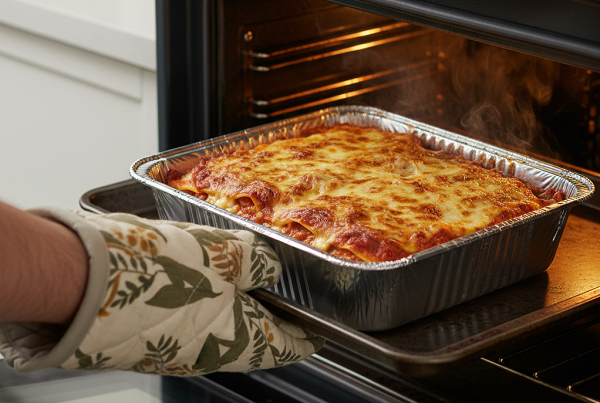
When the menu involves heavy sauces, high temperatures, or long-term storage, aluminum is unrivaled. Its impermeability ensures that messy foods stay contained, and its thermal conductivity allows it to transition effortlessly from freezer to oven.
Best Used For:
The Bakery Sector: For baking businesses dealing with cakes, pies, and pastries, aluminum is essential. It allows the product to be baked, displayed, and sold in the exact same vessel.
Hearty, Hot Meals: Dishes like lasagna, pasta bakes, and casseroles require a container that can withstand the weight and heat of the food without buckling.
Grease and Oil Heavy Foods: For roasted meats, grilled seafood, barbecues, and oily foods, aluminum provides a complete barrier. Unlike fiber, it will never absorb grease or leak at the bottom.
Heat-and-Eat Solutions: It is the industry standard for frozen-to-oven or ready-to-heat dishes. Supermarkets and meal-prep services rely on aluminum because customers can put the entire tray directly into the oven.
Delivery Efficiency: As restaurant containers for hot delivery, aluminum excels at trapping heat (especially when sealed with board lids), ensuring the food arrives piping hot.
Typical Product Types:
Foil pans: The versatile standard for entrees.
Aluminum trays: ideal for catering spreads and buffet service.
Disposable baking pans: Essential for loaves, brownies, and cobblers.
Quart takeout containers: Deep containers perfect for family-sized sides or heavy curries.
Foil lids or PET-lid food containers: Providing options for either heat retention (foil lid) or product visibility (clear PET lid).
When looking at takeout containers wholesale, cost is vital. Generally, standard aluminum foil containers are very cost-effective, often cheaper than high-quality molded fiber. However, as plastic bans increase and taxes on non-renewables rise, the price gap is narrowing. Bagasse containers are slightly more expensive to produce, but the marketing value they add to a brand can offset the cost.
Choosing between a bagasse container and an aluminum foil container depends on your business model. Here is a checklist to help you decide.
You Serve "Oven-Ready" Meals: If you sell Take-and-Bake pizzas, lasagnas, or casseroles.
The Food is Extremely Greasy or Liquid: Heavy gravies, oily BBQ, or very soupy entrees travel safer in foil with crimped lids.
Cost is the Primary Driver: You need the absolute lowest cost per unit for quart takeout containers.
Heat Retention is Priority: You want the food to stay steaming hot for a long delivery radius (and you use cardboard lids).
Customer Convenience: You know your customers will want to reheat their to go boxes in the microwave the next day.
Brand Image is Eco-Conscious: You market yourself as sustainable, organic, or farm-to-table. A bagasse food container reinforces this message visually.
Texture Matters: You serve fried foods that get soggy in foil or plastic. The breathability of bagasse keeps them crispier.
Safety: You want to avoid the risk of sharp metal edges or customers accidentally sparking their microwaves.
In conclusion, both bagasse containers and aluminum foil containers offer distinct advantages, and the better choice ultimately depends on a business’s food type, operational needs, and sustainability goals. Bagasse is ideal for brands prioritizing eco-friendly, compostable packaging and serving everyday meals that require microwave reheating. Aluminum foil containers excel in high-heat performance, leak resistance, and freezer-to-oven versatility, making them the preferred option for baked, roasted, or oily dishes. Understanding your menu, customer expectations, and local waste management systems will guide you toward the most suitable takeout packaging solution.
At Sumkoka, we specialize in providing top-tier takeout containers wholesale to meet the diverse needs of the food service industry. From sustainable bagasse bowls to durable clamshell containers, we have the right vessel for every dish on your menu. Whether you're a restaurant, café, or wholesaler, our product range and quality meet your needs. Comprehensive international certifications comply with plastic ban requirements in countries worldwide. Contact us today for more details!